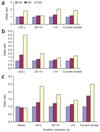Genome-wide association scan of tag SNPs identifies a susceptibility locus for lung cancer at 15q25.1
- PMID: 18385676
- PMCID: PMC2713680
- DOI: 10.1038/ng.109
Genome-wide association scan of tag SNPs identifies a susceptibility locus for lung cancer at 15q25.1
Abstract
To identify risk variants for lung cancer, we conducted a multistage genome-wide association study. In the discovery phase, we analyzed 315,450 tagging SNPs in 1,154 current and former (ever) smoking cases of European ancestry and 1,137 frequency-matched, ever-smoking controls from Houston, Texas. For replication, we evaluated the ten SNPs most significantly associated with lung cancer in an additional 711 cases and 632 controls from Texas and 2,013 cases and 3,062 controls from the UK. Two SNPs, rs1051730 and rs8034191, mapping to a region of strong linkage disequilibrium within 15q25.1 containing PSMA4 and the nicotinic acetylcholine receptor subunit genes CHRNA3 and CHRNA5, were significantly associated with risk in both replication sets. Combined analysis yielded odds ratios of 1.32 (P < 1 x 10(-17)) for both SNPs. Haplotype analysis was consistent with there being a single risk variant in this region. We conclude that variation in a region of 15q25.1 containing nicotinic acetylcholine receptors genes contributes to lung cancer risk.
Figures



References
-
- Tokuhata GK, Lilienfeld AM. Familial aggregation of lung cancer in humans. J. Natl. Cancer Inst. 1963;30:289–312. - PubMed
-
- Amos CI, Xu W, Spitz MR. Is there a genetic basis for lung cancer susceptibility? Recent Results Cancer Res. 1999;151:3–12. - PubMed
-
- Jonsson S, et al. Familial risk of lung carcinoma in the Icelandic population. J. Am. Med. Assn. 2004;22:2977–2983. - PubMed
-
- Hwang SJ, et al. Lung cancer risk in germline p53 mutation carriers: association between an inherited cancer predisposition, cigarette smoking, and cancer risk. Hum. Genet. 2003;113:238–243. - PubMed
Publication types
MeSH terms
Substances
Grants and funding
LinkOut - more resources
Full Text Sources
Other Literature Sources
Medical
Molecular Biology Databases
Miscellaneous

